This article is more than 5 years old.

One of the oldest printed books in ZSR’s Rare Books Collection is a Latin translation of Alī Ibn Abī al-Rijāl’s principal scientific work, Kitāb al-bāriʻ fī aḥkām al-nujūm. The text, commonly known as Liber in iudiciis astrorum, is a treatise on astrological methods by an 11th century Arab mathematician, printed in 1485 by a German printer working in Venice. The book is featured in the Special Collections exhibit Letters in Lead: Moveable Type and the Books It Created. Its history is a fascinating anecdote in the story of how print culture developed in Renaissance Europe.
Around 1450 a goldsmith in Mainz named Johannes Gutenberg developed a viable method for casting moveable type out of metal. The invention made mechanical printing feasible and gave rise to an entirely new profession in Renaissance Europe. Many aspiring printers learned the craft of printing from Gutenberg’s successors, and within a few years a coterie of printers had formed in Mainz. In 1462, however, warfare between rival sects of German Catholics led to the sack of Mainz and a diaspora of its printers around Europe. One of these displaced printers was Erhard Ratdolt, who transplanted his fledgling business to Venice.
Ratdolt flourished in his new location and quickly gained a reputation as an innovative printer of scientific texts. He experimented with multicolor printing and invented techniques for integrating woodcut illustrations and diagrams into pages of text. Ratdolt is particularly famous for producing the first printed text of Euclid’s Elements in 1482, and he specialized in printing editions of classic works of science and mathematics.
In 1485 Ratdolt printed the book in ZSR’s collection, a work on astronomy by the 11th century Tunisian court mathematician Alī Ibn Abī al-Rijāl, whose name was Latinized to Albohazen Haly or Haly Abenragel in European publications. Ratdolt’s volume bore the Latin title Preclarissimus liber completus in iudicijs astrorum ( The Complete Book on the Judgment of the Stars).

This astrological text was already well known to scholars in Renaissance Europe. It had been translated from Arabic into Castilian Spanish by astronomer Jehuda ben Moses Cohen in the 13th century, and from Spanish into a number of Latin translations.
In the world of the Renaissance, there was no sharp division between what we would call astronomy (the study of celestial bodies) and astrology (the influence of those celestial bodies on terrestrial events). Medieval astrology was based on an Aristotelian concept of the universe, as interpreted by Claudius Ptolemy , which posited a universe with a stationary Earth at its center, surrounded by concentric spheres containing stars, planets, and other celestial bodies.
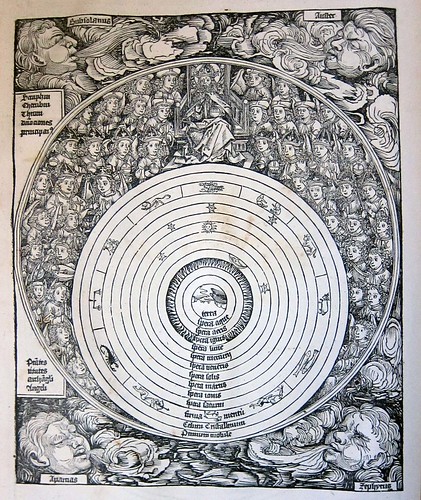
Medieval and Renaissance astrologers used mathematical formulas to predict the movement of objects in the sky. These calculations were used to create calendars, to determine propitious times for various activities, and to predict eclipses and other unusual events. Astrology was an important scientific pursuit, and Renaissance scholars eagerly sought to recover Arab and Byzantine astrological texts. The eastern astrologers had developed advanced techniques that were of great interest to scholars in western Europe.
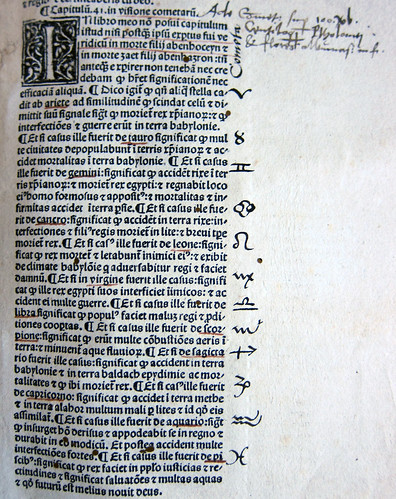
Erhard Ratdolt’s Venice edition of Liber in iudiciis astroroum made this text available in print for the first time. As an example of incunabula (books printed in Europe before 1500), it is both typical and innovative.
Fifteenth century books share many attributes of the manuscript volumes that existed for centuries before the invention of moveable type.

Like most early books, Ratdolt’s volume has no title page or table of contents. Its text was printed in black letter type, which reflected the manuscript handwriting prevalent in 15th century Europe.
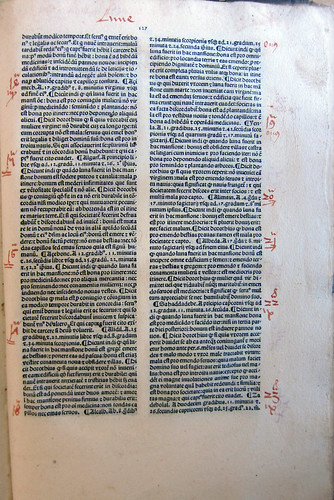
As in manuscript volumes, the text is printed in two columns with minimal punctuation. Medieval and Renaissance manuscript texts, like the one pictured above, relied on rubrication – initial letters and other text in colored ink—to indicate section breaks and other textual navigation. Early printed books often left space for rubrication to be added by hand to printed text, since multicolor printing was difficult and time consuming. Erhard Ratdolt hit upon the idea of using decorative woodcut initials in place of color.
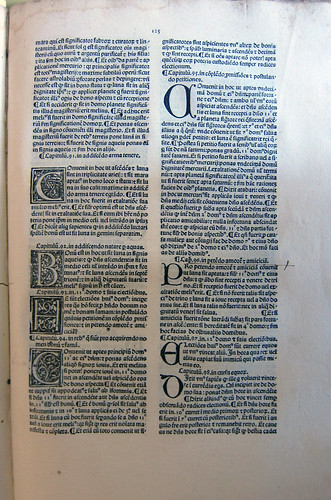

Ratdolt also pioneered techniques for including tables and woodcut charts in his pages of text, which was particularly important for scientific and mathematical books.
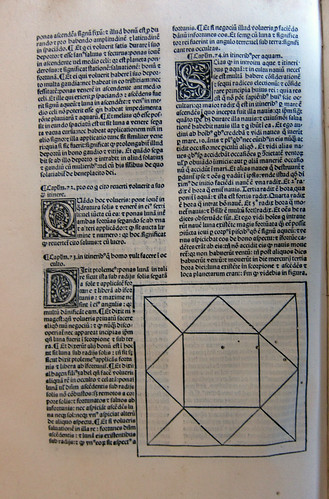
In the 1480s Erhard Ratdolt also printed editions of several other important astrological works. As historian Jonathan Green observes, Ratdolt “achieved a near monopoly during that decade for many astronomical and astrological works” [Printing and Prophecy (Ann Arbor: U. of Michigan Press, 2012) 135].
Ratdolt’s edition of Liber in iudiciis astroroum was a large and probably expensive book. But the original purchaser of ZSR’s copy obviously make good use of the volume. It was heavily annotated by its 15th century owner(s), with pages full of manuscript notes, underlinings, added headings, and astrological symbols.

Erhard Ratdolt’s Liber in iudiciis astroroum embodies the cultural exchanges and the technological innovations taking place in Renaissance Europe. ZSR’s copy of this book was purchased in 1964 with funds from the Oscar T. Smith endowment. It is on view in ZSR Library’s Special Collections and Archives Reading Room through April 30, as part of the Letters in Lead exhibit, which traces the development of printing type and book design in Europe from its beginnings through the 21st century.

2 Comments on ‘Complete Book on the Judgment of the Stars, by ʻAlī ibn Abī al-Rijāl (1485 Erhard Ratdolt edition)’
The technology of printing is amazing, thanks Megan!
This is absolutely fascinating. Impressive research, Megan!